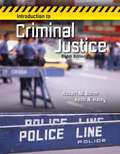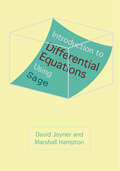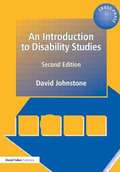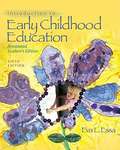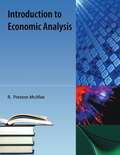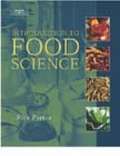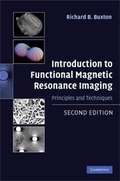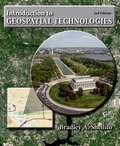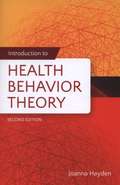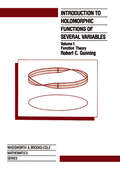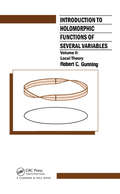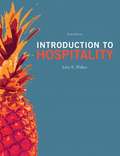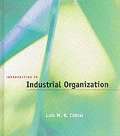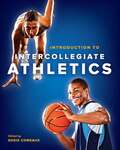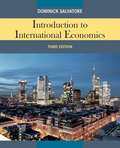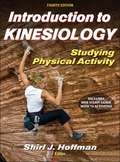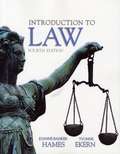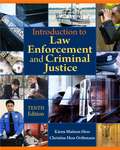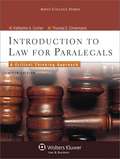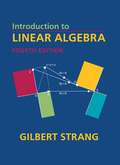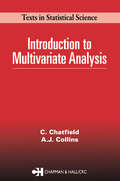- Table View
- List View
Introduction to Criminal Justice (Eighth Edition)
by Robert Bohm Keith HaleyIntroduction to Criminal Justice is the perfect text for students who are interested in pursuing a career in criminal justice and for those who simply want to learn more about the criminal justice system. The authors' combined experience of more than 50 years in teaching introduction to criminal justice as well as working in the field -- Bohm as a correctional officer and Haley as a police officer -- come through in their accessible yet comprehensive presentation. They make it easy for readers to understand that much of what the public "knows" about criminal justice in the United States is myth, and help students learn the truth about the U. S. criminal justice system. With the CourseSmart eTextbook version of this title, students can save up to 50% off the cost of a print book, reduce their impact on the environment, and access powerful web tools for learning. Faculty can also review and compare the full text online without having to wait for a print desk copy. CourseSmart is an online eTextbook, which means users need to be connected to the internet in order to access. Students can also print sections of the book for maximum portability.
Introduction to Differential Equations Using Sage
by David Joyner Marshall HamptonDifferential equations can be taught using Sage as an inventive new approach.David Joyner and Marshall Hampton's lucid textbook explains differential equations using the free and open-source mathematical software Sage.Since its release in 2005, Sage has acquired a substantial following among mathematicians, but its first user was Joyner, who is credited with helping famed mathematician William Stein turn the program into a usable and popular choice. Introduction to Differential Equations Using Sage extends Stein's work by creating a classroom tool that allows both differential equations and Sage to be taught concurrently. It's a creative and forward-thinking approach to math instruction.Topics include: • First-Order Differential Equations • Incorporation of Newtonian Mechanics• Second-Order Differential Equations• The Annihilator Method• Using Linear Algebra with Differential Equations• Nonlinear Systems• Partial Differential Equations• Romeo and Juliet
Introduction to Disability Studies
by David JohnstoneAn introductory text that explores the current issues in the lives and circumstances of disabled people, their careers, and those who intend to work in the caring services. Explores and analyzes quality of life factors, the emergence of rights, and the strengths and weakness of community care provisions. Also provides examples of individual oppressions and success stories, and suggests how disabled and non-disabled people can collaborate in the development of inclusive communities and neighborhoods. Distributed by Taylor & Francis. Annotation c. by Book News, Inc., Portland, OR.
Introduction to Early Childhood Education (6th Edition, Annotated Student’s Edition)
by Eva L. EssaThe book provides a comprehensive overview of early childhood education that is solidly based on current research and theories. The text, inter alia, examines curriculum and the fostering of creativity, as well as physical, cognitive, language, and social development--and every facet of early childhood education is examined and explained. This extensively revised edition includes new standards and accountability in the field of early childhood education.
Introduction to Economic Analysis
by R. Preston McafeeThis book presents introductory economics ("principles") material using standard mathematical tools, including calculus. It is designed for a relatively sophisticated undergraduate who has not taken a basic university course in economics. It also contains the standard intermediate microeconomics material and some material that ought to be standard but is not. The book can easily serve as an intermediate microeconomics text. The focus of this book is on the conceptual tools and not on fluff. Most microeconomics texts are mostly fluff and the fluff market is exceedingly over-served by $100+ texts. In contrast, this book reflects the approach actually adopted by the majority of economists for understanding economic activity. There are lots of models and equations and no pictures of economists.
Introduction to Economic Analysis
by R. Preston Mcafee Tracy R. LewisThis book presents standard intermediate microeconomics material and some material that, in the authors' view, ought to be standard but is not. Introductory economics material is integrated. Standard mathematical tools, including calculus, are used throughout. The book easily serves as an intermediate microeconomics text, and can be used for a relatively sophisticated undergraduate who has not taken a basic university course in economics. The focus of this book is on the conceptual tools and not on fluff. As such, it reflects the approach actually adopted by the majority of economists for understanding economic activity. There are lots of models and equations, and no pictures of economists ;-) Economic analysis is used in many situations. When British Petroleum sets the price for Alaskan crude oil, it uses an estimated demand model, both for gasoline consumers and also for the refineries to which BP sells. Economic analysis was used by experts in the antitrust suit brought by the U.S. Department of Justice both to understand Microsoft s incentive to foreclose (eliminate from the market) rival Netscape and consumer behavior in the face of alleged foreclosure. Stock market analysts use economic models to forecast the profits of companies to predict the price of their stocks. When the government forecasts the budget deficit or considers a change in environmental regulations, it uses economic models. This book presents the building blocks of the models in common use by an army of economists thousands of times per day. This book, plus econometrics, provides most of the economic analysis tools to take upper division economics courses of any type.
Introduction to Economic Analysis
by R. Preston Mcafee Tracy R. LewisThis book presents standard intermediate microeconomics material and some material that, in the authors' view, ought to be standard but is not. Introductory economics material is integrated. Standard mathematical tools, including calculus, are used throughout. The book easily serves as an intermediate microeconomics text, and can be used for a relatively sophisticated undergraduate who has not taken a basic university course in economics. The focus of this book is on the conceptual tools and not on fluff. As such, it reflects the approach actually adopted by the majority of economists for understanding economic activity. There are lots of models and equations, and no pictures of economists ;-) Economic analysis is used in many situations. When British Petroleum sets the price for Alaskan crude oil, it uses an estimated demand model, both for gasoline consumers and also for the refineries to which BP sells. Economic analysis was used by experts in the antitrust suit brought by the U.S. Department of Justice both to understand Microsoft s incentive to foreclose (eliminate from the market) rival Netscape and consumer behavior in the face of alleged foreclosure. Stock market analysts use economic models to forecast the profits of companies to predict the price of their stocks. When the government forecasts the budget deficit or considers a change in environmental regulations, it uses economic models. This book presents the building blocks of the models in common use by an army of economists thousands of times per day. This book, plus econometrics, provides most of the economic analysis tools to take upper division economics courses of any type.
Introduction to Environmental Science
by Susannah SandrinIntroduction To Environmental Science by Susannah Sandrin
Introduction to Food Science
by Rick Parker"Introduction to Food Science" provides an overview of the science of foods, from nutrition and digestion to processing and preservation. The material is based on a thorough, easy-to-follow outline that makes developing a lesson plan simple. Each chapter contains a list of learning objectives that help identify important concepts and key words that are essential to the understanding of the material. Tables, charts, graphs and illustrations are inserted throughout the text, providing quick and understandable access to information. The "student activities" section at the end of each chapter provide opportunities to directly apply material. The text also provides insight into career opportunities for those interested in working within food science industries.
Introduction to Functional Magnetic Resonance Imaging
by Richard B. BuxtonFunctional Magnetic Resonance Imaging (fMRI) has become a standard tool for mapping the working brain's activation patterns, both in health and in disease. It is an interdisciplinary field and crosses the borders of neuroscience, psychology, psychiatry, radiology, mathematics, physics and engineering. Developments in techniques, procedures and our understanding of this field are expanding rapidly. In this second edition of Introduction to Functional Magnetic Resonance Imaging, Richard Buxton - a leading authority on fMRI - provides an invaluable guide to how fMRI works, from introducing the basic ideas and principles to the underlying physics and physiology. He covers the relationship between fMRI and other imaging techniques and includes a guide to the statistical analysis of fMRI data. This book will be useful both to the experienced radiographer, and the clinician or researcher with no previous knowledge of the technology.
Introduction to Geospatial Technologies (Second Edition)
by Bradley A. ShellitoCombining both theoretical coverage and hands-on lab work, and accessible to majors and non-majors alike, Bradley Shellito's Introduction to Geospatial Technologies has become a new favorite for the digital Earth course. The new edition reflects the latest developments in the field, including how scientists are using GIS data with cloud technology. With lab activities that utilize both widely available freeware and ArcGIS, instructors can tailor the course to their students.
Introduction to Health Behavior Theory (Second Edition)
by Joanna Aboyoun HaydenIntroduction to Health Behavior Theory, Second Edition is designed to provide students with an easy to understand, interesting, and engaging introduction to the theoretical basis of health education. Written with the undergraduate in mind, the text uses comprehensive and accessible explanations to help students understand what theory is, how theories are developed, and what factors influence health behavior theory. Covering the more frequently used health behavior theories, the author breaks each theory into concepts and constructs to enhance comprehension and encourage students to discover how these theories can be put into practice. New to the Second Edition:* Data, information, and illustrations updated throughout, including the new "My Plate"* A new Theory in Action article and new classroom activities in each theory chapter* New and revised chapters on Social Ecological Models and Social Capital Theory
Introduction to Holomorphic Functions of Several Variables, Volume I: Homological Theory
by R.C. GunningIntroduction to Holomorphlc Functions of SeveralVariables, Volumes 1-111 provide an extensiveintroduction to the Oka-Cartan theory of holomorphicfunctions of several variables and holomorphicvarieties. Each volume covers a different aspect andcan be read independently.
Introduction to Holomorphic Functions of Several Variables, Volume II: Homological Theory
by R.C. GunningIntroduction to Holomorphlc Functions of SeveralVariables, Volumes 1-111 provide an extensiveintroduction to the Oka-Cartan theory of holomorphicfunctions of several variables and holomorphicvarieties. Each volume covers a different aspect andcan be read independently.
Introduction to Hospitality (6th edition)
by John R. WalkerThe Sixth Edition of Introduction to Hospitality focuses on hospitality operations while offering a broad, comprehensive foundation of current knowledge about the world's largest industry. The text is organized into five sections: the hospitality industry and tourism; lodging; restaurants, managed services, and beverages; recreation, theme parks, clubs, and gaming entertainment; and assemblies and event management.
Introduction to Industrial Organization
by Luís M. B. CabralOver the past twenty years, the study of industrial organization--the analysis of imperfectly competitive markets--has grown from a niche area of microeconomics to a key component of economics and of related disciplines such as finance, strategy, and marketing. This book provides an issue-driven introduction to industrial organization. It includes a vast array of examples, from both within and outside the United States. While formal in its approach, the book is written in a way that requires only basic mathematical training. Supplemental materials posted on the Web make more extensive use of algebra and calculus.
Introduction to Intercollegiate Athletics
by Eddie ComeauxA comprehensive critical exploration of the intricacies of college-level athletics.Intercollegiate athletics continue to bedevil American higher education. At once tied closely with their institutions, athletic programs often operate outside the traditional university governance structure while contributing significantly to a school's culture, identity, and financial outlook. Introduction to Intercollegiate Athletics, edited by Eddie Comeaux, explores the complexities of intercollegiate athletics while explaining the organizational structures, key players, terms, and important issues most relevant to the growing but often misunderstood fields of recreational studies, sports management, and athletic administration.The book is divided into eight sections, the first three of which describe the foundations, overarching structures, and conditions that shape athletics and higher education. Three others explore the ways college athletes experience life on campus, and the final two delve into the current and future policy contexts of intercollegiate athletics. Written by a diverse group of expert scholars, the book's twenty-eight chapters are enhanced with useful glossaries, reflections from athletics stakeholders, relevant case studies, and conversation-provoking discussion questions. Aimed at upper-level undergraduate and graduate students, scholars, teachers, practitioners, athletic administrators, and advocates of intercollegiate athletics, Introduction to Intercollegiate Athletics provides readers with up-to-date and comprehensive knowledge about the changes to—and challenges faced by—university athletics programs.
Introduction to International Economics (Third Edition)
by Dominick SalvatoreThe aim of this text is to provide the student with an introduction to the field of international economics using many real-world case studies.
Introduction to Kinesiology: Studying Physical Activity
by Shirl J. HoffmanIntroduction to Kinesiology: Studying Physical Activity, Fourth Edition, is the most cohesive introduction to the field of kinesiology available, demonstrating how its many disciplines integrate into a unified body of knowledge. This all-inclusive approach gives students a solid background in the field and prepares them for further study and course work. This engaging and jargon-free text also introduces students to job prospects and areas of study and professional practice in kinesiology. Introduction to Kinesiology, Fourth Edition, orients and prepares students for in-depth studies in their areas of interest. Its broad scope acknowledges students' diverse interests and aspirations in professional and scholarly career tracks as well as teaching and coaching. Top kinesiologists expand discussion of physical activity beyond exercise, sport, or health-related activity in an effort to broaden conceptions of physical activity and the potential contributions of kinesiology. The contributors, each with specific expertise in the subdisciplines, share their perspectives in chapters complemented by full-color photos and illustrations.
Introduction to Law (4th Edition)
by Joanne Banker Hames Yvonne EkernThis 4th edition aims to teach U.S. students the basic concepts related to substantive and procedural law, introduces them to cases, statutes, and the constitution, and develops their legal vocabulary and analytical skills. It contains a new chapter on constitutional law and expanded coverage of employment and environmental law.
Introduction to Law Enforcement and Criminal Justice (Tenth Edition)
by Kären M. Hess Christine Hess OrthmannINTRODUCTION TO LAW ENFORCEMENT AND CRIMINAL JUSTICE, 10th edition provides readers with comprehensive information on both law enforcement and the criminal justice system, all in one convenient book. This very practical, applied book not only examines the role of police within the larger criminal justice system but it also introduces readers to the other components of that system such as the courts, corrections, and juvenile justice. INTRODUCTION TO LAW ENFORCEMENT AND CRIMINAL JUSTICE, 10th edition has a uniquely accessible writing style with many real-world examples and has a "boots on the street" perspective. This new edition includes an extensive discussion of data-driven strategies and policing, such as CompStat policing, intelligence-led policing and evidence based policing. Readers will also learn about controversies surrounding immigration law enforcement and several new Supreme Court cases affecting law enforcement and the criminal justice system.
Introduction to Law for Paralegals: A Critical Thinking Approach (5th Edition)
by Thomas E. Eimermann Katherine A. Curriera comprehensive and accessible text, specifically written for paralegal students, Introduction to Law for Paralegals provides an in-depth introduction to the key concepts in the American legal system, research and analysis of legal material, as well as legal ethics and substantive law. Supported by strong pedagogy and a critical-thinking approach to edited cases, the material is engaging, well-written and highly teachable. the Fifth Edition has been updated to reflect new cases and changes in statutory law, with new reasoning exercises to challenge and engage students. Updated Internet references and Web-based exercises are also included. The rich Appendix now includes the full text of the U. S. Constitution. Features:Comprehensive, accessible overview of all key concepts covered in an introduction to law course. Highly teachable style, with detailed Instructor's Manual, TestBank and PowerPoints. In-depth coverage written specifically for paralegal students,including:the role of the paralegal. Sources and classification of law. Structure of the court system. Overview of litigation Basics of legal analysis, research, and writing. Legal ethics and substantive law. Critical-thinking approach introduces students to the study of law. Use of edited cases to teach students how to read and analyze the law. Engaging hypotheticals, examples, and well-designed question s. Material presented in organized and well-written format. Strong pedagogy throughout includes:Ethic alerts. Marginal definitions. Internet references. Legal reasoning exercises. Appendices on good writing, citation form, ethical codes and Netnotes. Thoroughly updated, the revised Fifth Edition includes:Streamlined presentation. New cases and changes in statutory law. New Web-based exercises. Updated Internet references throughout. New legal reasoning exercises reflecting current cases. Complete U. S. Constitution as an appendix.
Introduction to Linear Algebra (4th Edition)
by Gilbert StrangThis leading textbook for first courses in linear algebra comes from the hugely experienced MIT lecturer and author Gilbert Strang. The book's tried and tested approach is direct, offering practical explanations and examples, while showing the beauty and variety of the subject. Unlike most other linear algebra textbooks, the approach is not a repetitive drill. Instead it inspires an understanding of real mathematics. The book moves gradually and naturally from numbers to vectors to the four fundamental subspaces. This new edition includes challenge problems at the end of each section.
Introduction to Multivariate Analysis (Chapman And Hall/crc Texts In Statistical Science Ser. #1)
by Chris ChatfieldThis book provides an introduction to the analysis of multivariate data.It describes multivariate probability distributions, the preliminary analysisof a large -scale set of data, princ iple component and factor analysis,traditional normal theory material, as well as multidimensional scaling andcluster analysis.Introduction to Multivariate Analysis provides a reasonable blend oftheory and practice. Enough theory is given to introduce the concepts andto make the topics mathematically interesting. In addition the authors discussthe use (and misuse) of the techniques in pra ctice and present appropriatereal-life examples from a variety of areas includ ing agricultural research,soc iology and crim inology. The book should be suitable both for researchworkers and as a text for students taking a course on multivariate analysis.
Introduction to Mythology: Contemporary Approaches to Classical and World Myths (3rd Edition)
by Eva M. Thury Margaret K. DevinneyIntegrating original texts with explanations, interpretations, and theory, Introduction to Mythology: Contemporary Approaches to Classical and World Myths, Third Edition, introduces students to a wide range of myths drawn from sources all around the world and approached from various critical perspectives. The third edition strengthens its global coverage with two new chapters: Chapter 11, "Mesoamerica: Popol Vuh," and Chapter 43, "The Vampire as Hero: Tales of the Undead in a Contemporary Context."
